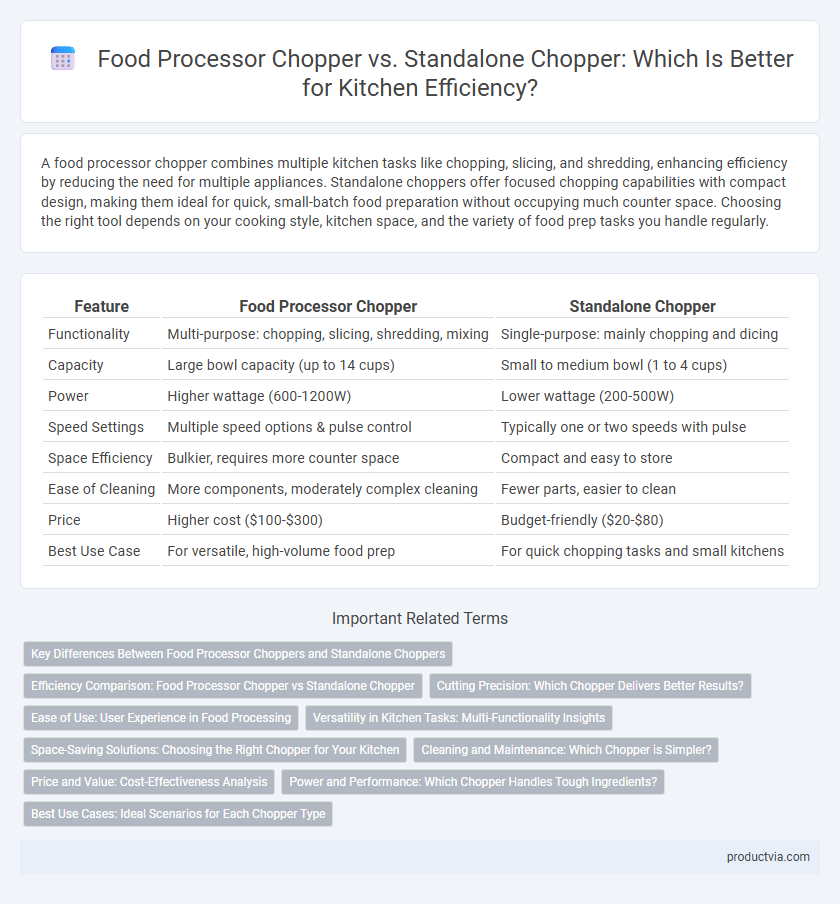A food processor chopper combines multiple kitchen tasks like chopping, slicing, and shredding, enhancing efficiency by reducing the need for multiple appliances. Standalone choppers offer focused chopping capabilities with compact design, making them ideal for quick, small-batch food preparation without occupying much counter space. Choosing the right tool depends on your cooking style, kitchen space, and the variety of food prep tasks you handle regularly.
Table of Comparison
| Feature | Food Processor Chopper | Standalone Chopper |
|---|---|---|
| Functionality | Multi-purpose: chopping, slicing, shredding, mixing | Single-purpose: mainly chopping and dicing |
| Capacity | Large bowl capacity (up to 14 cups) | Small to medium bowl (1 to 4 cups) |
| Power | Higher wattage (600-1200W) | Lower wattage (200-500W) |
| Speed Settings | Multiple speed options & pulse control | Typically one or two speeds with pulse |
| Space Efficiency | Bulkier, requires more counter space | Compact and easy to store |
| Ease of Cleaning | More components, moderately complex cleaning | Fewer parts, easier to clean |
| Price | Higher cost ($100-$300) | Budget-friendly ($20-$80) |
| Best Use Case | For versatile, high-volume food prep | For quick chopping tasks and small kitchens |
Key Differences Between Food Processor Choppers and Standalone Choppers
Food processor choppers combine multiple kitchen functions such as slicing, dicing, and shredding with chopping capabilities, improving multitasking efficiency. Standalone choppers specialize exclusively in chopping, often providing faster and more precise results for specific tasks like herbs and nuts. Choosing between the two depends on kitchen space, frequency of use, and desired versatility for meal preparation.
Efficiency Comparison: Food Processor Chopper vs Standalone Chopper
A food processor chopper integrates multiple kitchen functions, allowing for chopping, slicing, and pureeing in one device, which streamlines food preparation and reduces countertop clutter. Standalone choppers, designed specifically for chopping tasks, often excel in precision and speed but lack the multifunctionality of food processors. For kitchen efficiency, a food processor chopper offers versatility and time-saving benefits, while standalone choppers provide focused performance for repetitive chopping needs.
Cutting Precision: Which Chopper Delivers Better Results?
Food processor choppers offer superior cutting precision due to powerful motors and multiple blade attachments, enabling uniform slices, dices, and chops with minimal effort. Standalone choppers typically feature fewer settings and blades, resulting in less consistent cuts and limited versatility for intricate food preparation. For kitchen efficiency focused on precision, food processor choppers deliver more reliable and professional-quality results.
Ease of Use: User Experience in Food Processing
Food processor choppers integrate multiple functions in one device, offering versatility but sometimes complicating ease of use due to various settings and attachments. Standalone choppers prioritize simplicity with one-touch operation and fewer components, enhancing user experience for quick, straightforward food processing tasks. Choosing between the two depends on balancing multifunctionality against intuitive, user-friendly design for efficient kitchen workflow.
Versatility in Kitchen Tasks: Multi-Functionality Insights
Food processor choppers offer multi-functionality by combining chopping, slicing, grating, and mixing capabilities, enhancing kitchen efficiency through versatile food preparation. Standalone choppers excel in rapid, precise chopping tasks with simpler design and quicker cleanup, ideal for small to medium food processing needs. Choosing between the two depends on required kitchen tasks, available space, and the need for multiple functions versus specialized chopping performance.
Space-Saving Solutions: Choosing the Right Chopper for Your Kitchen
Food processor choppers combine multiple functions in one appliance, saving countertop space and reducing the need for separate devices in small kitchens. Standalone choppers are compact and easy to store, ideal for quick chopping tasks without occupying significant space. Prioritizing kitchen efficiency, selecting a food processor chopper or standalone chopper depends on balancing multifunctionality with available storage options.
Cleaning and Maintenance: Which Chopper is Simpler?
Standalone choppers offer simpler cleaning and maintenance due to their compact design and fewer detachable parts, making them ideal for quick kitchen tasks. Food processor choppers, while more versatile, often require disassembling larger components and careful cleaning to maintain functionality. For users prioritizing efficient cleanup, standalone choppers provide a time-saving advantage over multifunctional food processors.
Price and Value: Cost-Effectiveness Analysis
Food processor choppers typically offer multifunctional capabilities, combining slicing, dicing, and chopping functions, which translates to higher upfront costs but greater long-term value for diverse kitchen tasks. Standalone choppers have lower initial prices and are ideal for users prioritizing basic chopping needs and budget constraints, though they may require additional appliances for more complex food preparation. Analyzing cost-effectiveness, food processor choppers provide enhanced efficiency and space-saving benefits that justify their premium price in busy kitchens.
Power and Performance: Which Chopper Handles Tough Ingredients?
Food processor choppers generally offer higher wattage motors ranging from 600 to 1200 watts, enabling them to handle tough ingredients like nuts, hard vegetables, and frozen items with ease. Standalone choppers typically have lower power, between 200 to 400 watts, which limits their performance on dense or fibrous foods. For kitchen efficiency, choosing a food processor chopper ensures superior power and consistent chopping performance on challenging ingredients.
Best Use Cases: Ideal Scenarios for Each Chopper Type
Food processor choppers excel in handling large volumes and complex food preparation tasks such as chopping vegetables, kneading dough, and slicing fruits, making them ideal for busy kitchens requiring multifunctional appliances. Standalone choppers are best suited for quick, small-scale chopping jobs like herbs, nuts, or onions, providing convenience and speed for everyday meal prep without the bulk of a larger device. Choosing between the two depends on kitchen space, frequency of use, and the variety of food preparation needs.
Food processor chopper vs Standalone chopper for kitchen efficiency Infographic

 productvia.com
productvia.com